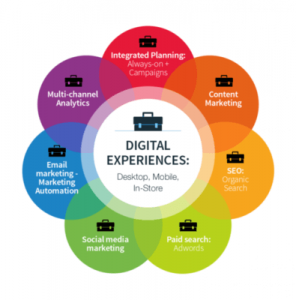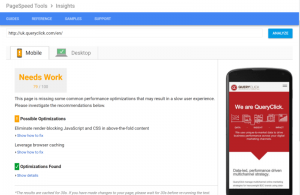Thanks for coming back to get Part 2 of this blog post on conversion rate optimization (CRO). We left off talking about how, like all digital marketing efforts, to successfully increase your conversion rates you have to develop a plan. There are 4 main parts to a conversion plan:
- Identify what your goals are for conversions
- Develop a baseline
- Setup a way to measure your results
- Develop a testing procedure for improvement
- Evaluate and improve
In this post, we’re going to look at each of these 4 components to a conversion rate optimization plan and talk about how to get started.
Goals
Before you start working on improving your conversions, you have to know where you’re going. Goals for conversion typically focus on the final step in the buying process. Things like more contact us forms filled out, or more product sales trough an online store. But what about businesses that have a more complex sell cycle. Businesses like auto dealerships or B2B companies. These business environments have customers that take an amount of time to make their decision. They educate themselves on the products, the companies, and even the solutions that they are committing to. In these scenarios, there are a number of conversions that have to happen before the customer is ready to fill out the contact us form or to put a product into a shopping cart and pay for it. And, if you’re not focusing on the conversion steps that have to take place before they commit to a purchase, they will just leave.
For complex sales, conversion goals will focus on getting the prospect to engage in the areas of the website that will answer the questions that they have before they make a decision. As an example, let’s say that you sell a widget on your website that solves a problem for manufacturers but you know that before anyone buys one of your widgets you have to educate them on how the widget works, the savings that they will get when they install your widget, and what size widget will be right for them.
In this scenario, your conversion goals should be activities like:
- Time spent on the “solutions” page of your website
- Downloading a white paper from the resources area of your website
- Time spent on the about us page of your website
- Downloading a case study from your website
All of these activities demonstrate people that are qualifying themselves as they get the answers to their purchase decision. Your goals should then focus on these activities.
Baseline
Everything about conversion rate optimization (CRO) is focused on growing but before you can identify growth you have to know where you started from. Now, chances are that you probably haven’t setup your website for all of the conversion points, so start your baseline with what you have. If you have Google Analytics installed on your site, you’ll be able to get an amazing amount of information from there.
- Measure the time on page of the most important pages of your website. Pages like product description pages, solutions pages and even your about us page.
- Measure your bounce rate (for the whole site) and for these important pages that you have identified. Find out what pages are responsible for driving your visitors away.
- If you have more than 1 form on your site, measure the conversion rates for these forms.
- Conversion Rate Formula: (# of form entries ÷ # of visitors)
- Traffic source is an important measurement because you will be able to eliminate areas that you don’t sell to (i.e. Russia probably not a great source of traffic for most businesses)
Setup Measurements
As I mentioned earlier, Google Analytics (GA) is a great start for measuring conversions. If you don’t have it installed on your site, get it installed as soon as you can. Their basic package is free and the installation can be handled by virtually anyone that has some web programming experience.
Within GA there are some reports that you will want to make sure that you get setup:
- Unique Page Views: behavior -> site content -> all pages: This report will give you information like, bounce rates, time on page, % entrance, and % exit, for each page on your site.
- User Flow: audience -> user flow: This report will give you a graph of how your website visitors travel through you site.
- Goals: conversion -> goals: This report will take a little bit of setup but it will be well worth the effort. You will be able to set it up to measure when conversion activities like forms getting filled out, happen.
Test, Test, & Test
Once you commit to CRO you’ll find that it can be a bit addictive. If you go from a 3% conversion to a 5% conversion, you’re going to want to get to a 10% conversion. The best way to continue increasing your conversion rates is to test different scenarios.
We’ve all heard about the mythical company that changed their old gray submit button to green and saw a 3,000% increase in conversions. Don’t be disappointed when this doesn’t happen to you. Conversion rate optimization is more complicated that this.
Figure out a scenario for what you think would impact your customer and then make that change. Once the change is made, measure the results, compare the results to what you were doing and compare the difference. This is why establishing a baseline is so important. If you don’t have a baseline set, you won’t know if you’re improving.
Here are some quick and easy things to get started testing:
- Shorten every form on your site to collect just the basic information that you need. If you’re trying to generate sales leads for your sales team, you don’t have to ask 20 questions about their business, sales volume, profit margins, etc. Just get contact information (if your site is setup with a marketing automation platform you can find what product they were looking at from there).
- Setup navigation based on the different segments of customers that you sell to. Let them go to the area that just talks to them.
- Stop using industry jargon on your website. The biggest problem with website’s today is a visitor’s inability to read a page and understand what the company is saying.
- Give the visitor the information that they need, at each stage of the buying cycle. They will not contact you before they are ready to talk to someone and if you don’t give them the early stage information, they will go to a site that does.
(29)
Report Post



